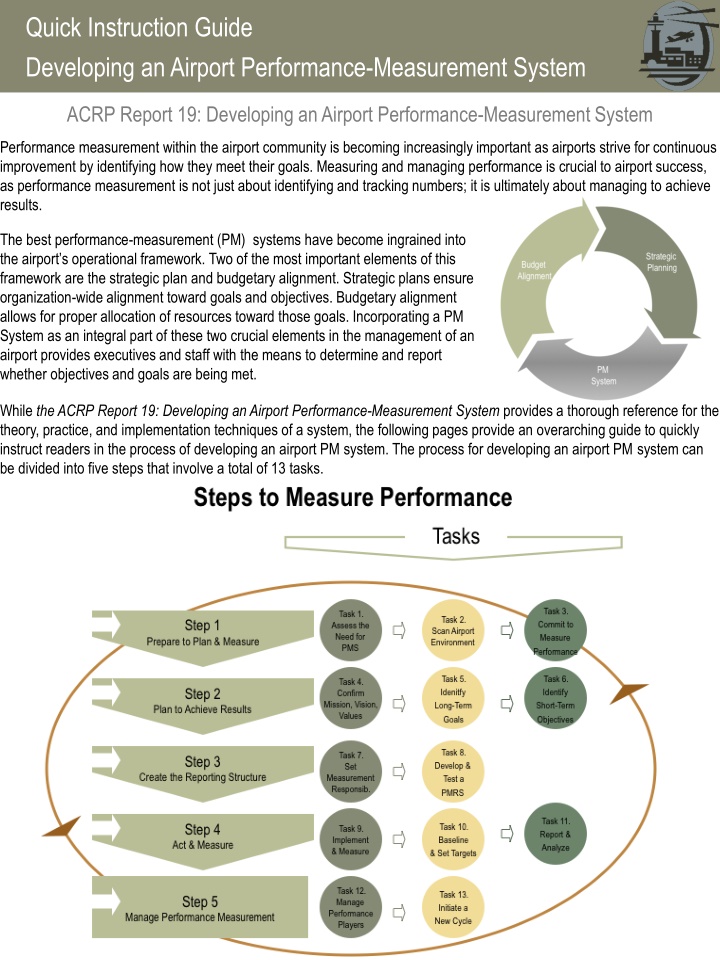
Developing an Airport Performance Measurement System: Quick Guide
Establishing a performance measurement system is crucial for airports aiming for continuous improvement. This guide outlines a step-by-step process for developing an airport performance measurement system, emphasizing the importance of strategic planning and budgetary alignment. With commitment and proper assessment, airports can effectively measure and manage their performance to achieve desired results.
Download Presentation

Please find below an Image/Link to download the presentation.
The content on the website is provided AS IS for your information and personal use only. It may not be sold, licensed, or shared on other websites without obtaining consent from the author. If you encounter any issues during the download, it is possible that the publisher has removed the file from their server.
You are allowed to download the files provided on this website for personal or commercial use, subject to the condition that they are used lawfully. All files are the property of their respective owners.
The content on the website is provided AS IS for your information and personal use only. It may not be sold, licensed, or shared on other websites without obtaining consent from the author.
E N D
Presentation Transcript
Quick Instruction Guide Developing an Airport Performance-Measurement System ACRP Report 19: Developing an Airport Performance-Measurement System Performance measurement within the airport community is becoming increasingly important as airports strive for continuous improvement by identifying how they meet their goals. Measuring and managing performance is crucial to airport success, as performance measurement is not just about identifying and tracking numbers; it is ultimately about managing to achieve results. The best performance-measurement (PM) systems have become ingrained into the airport s operational framework. Two of the most important elements of this framework are the strategic plan and budgetary alignment. Strategic plans ensure organization-wide alignment toward goals and objectives. Budgetary alignment allows for proper allocation of resources toward those goals. Incorporating a PM System as an integral part of these two crucial elements in the management of an airport provides executives and staff with the means to determine and report whether objectives and goals are being met. While the ACRP Report 19: Developing an Airport Performance-Measurement System provides a thorough reference for the theory, practice, and implementation techniques of a system, the following pages provide an overarching guide to quickly instruct readers in the process of developing an airport PM system. The process for developing an airport PM system can be divided into five steps that involve a total of 13 tasks.
STEP 1 PREPARETO PLANAND MEASURE THEFIRSTSTEPINIMPLEMENTINGANYPROCESSISTOCONSIDERWHYYOUNEEDIT, WHATISNEEDED, ANDWHETHERTHERE WILLBEACOMMITMENTTOEXECUTEANDIMPLEMENTIT. With commitment, the airport can greatly improve its performance through focused efforts aimed at achieving measurable goals, so it is important to assess airport director and senior executive commitment to PM systems Evaluate the particular needs of the airport: Determine whether a PM system is needed Identify the benefits of having a PM system List actions necessary to obtain understanding of and commitment to implementing a PM system Task 2 Scan Airport Environment An environmental assessment of the airport business will help determine what will be needed to establish a PM system. You will need to: Identify internal and external stakeholders Conduct a SWOT Analysis, Trend Analysis, or Gap Analysis Identify action items and expected outcome measures Task 3 Task 1 Commit to Measure Performance Assess the Need for a PM System REFERENCE TOOLS.STEP 1:WORKSHEETS #1, #2, AND #3 GUIDEBOOK PART II CHAPTER 1 STEP 2: WORKSHEETS #4, #5, AND #6 GUIDEBOOK PART II CHAPTER 2 STEP 2 PLANTO ACHIEVE RESULTS ONEOFTHEMOSTCRITICALELEMENTSOFANAIRPORT SPERFORMANCE-MEASUREMENTPROCESSISTHEEXISTENCEOFAN AIRPORTSTRATEGICPLAN. THELINKAGEBETWEENTHEPLANNINGPROCESSANDTHEPMSYSTEMISSTRAIGHTFORWARD: WITH NOSTRATEGIES, THERECANNOTBETHOUGHTFULDEVELOPMENTOFTHEPROPERPERFORMANCEMEASURES. Task 5 This area forms the initial and primary bridge between a strategic plan and a performance measurement framework: Confirm that the airport s mission statement and values are quantifiable List the expected results from the airport s mission statement Based on the long-term objectives and conclusions of the environmental scan, identify short-term and intermediate measures to quantify the objectives of proposed actions: Identify intermediate and short- term objectives Define corresponding measures Identify Long-Term Goals The first step in establishing performance measures is to extract long-term objectives from the mission, vision, and values. Identify current long-term objectives List key performance indicators (KPIs) for each long-term objective Identify current outcome measures and gaps Task 6 Task 4 Identify Short-Term Objectives Confirm Mission, Vision, and Values
STEP 3 CREATETHE REPORTING STRUCTURE ONCEMEASURESARESET, THEAIRPORTNEEDSTOSETRESPONSIBILITIESFOREACHOBJECTIVE, INITIATIVE, ANDMEASURE ANDTHENHOLDPEOPLE, ANDTHEIRGROUPS, ACCOUNTABLEFORMONITORINGANDREPORTING Task 8 Successful deployment of an integrated PM system is strongly related strongly to developing a system of accountability. Set responsibilities for measuring each objective and initiative Identify individuals accountable for monitoring and reporting each measure Develop and Test a PM Reporting System Create a performance reporting structure: Create and operate a performance reporting structure Determine PM software needs Populate the PM reporting system Beta-test the PM reporting system Task 7 Set Measurement Responsibilities REFERENCE TOOLS.STEP 3:WORKSHEETS #7 AND #8 GUIDEBOOK PART II CHAPTER 3 STEP 4: WORKSHEETS #9, #10 AND #11 GUIDEBOOK PART II CHAPTER 4 STEP 4 ACTAND MEASURE ONCEOBJECTIVESANDMEASURESHAVEBEENDEFINEDANDRESPONSIBILITIESSET, THEAIRPORTWILLMONITORITS PERFORMANCE. ASPARTOFTHATPROCESS, THEAIRPORTWILLBASELINEITSMEASURESANDTHENSETTARGETSFORWHATIT WILLACHIEVEINTHEFUTURE. FINALLY, ITWILLREPORTANDANALYZEPERFORMANCEDATATHATWILLBEUSEDINTHE DECISION-MAKINGPROCESS. Task 10 Successful implementation of initiatives, projects, and programs is at the forefront of how the airport achieves its goals: Establish an efficient data collection system Maximize data integrity and accuracy Interpret performance internally and externally Data must be reported to and analyzed by management to improve performance. For an airport-wide PM system to be successful: Provide schedules, formats, and requirements to key performance players Provide information to airport management as close to real-time as possible Define stakeholder communication and outreach plan Baseline Measures and Set Targets Before the process begins make sure you have: Baselined each measure by determining where the airport is today and the trend of the measure Set targets for what the airport will achieve, and by when, based on the airport goals Task 9 Implement and Measure Task 11 Report and Analyze
STEP 5MANAGE PERFORMANCE MEASUREMENT THEFINALSTEPINTHE PM CYCLEISFORTHE CORE TEAMTOMANAGETHEAIRPORT SPERFORMANCEREPORTINGAND MANAGEMENTSYSTEMANDCOORDINATETHEPROCESSOFINITIATINGANEWCYCLEOFTHE PM SYSTEM. Although the PM system structure may differ from airport to airport, there should always be one person or group in charge of the PM system that will collect data from other departments and coordinate the processes of the PM system: Evaluate performance players efforts based on quality and timeliness of reported data Assess the use of assigned resources Conduct internal audits to verify validity of performance data Task 13 Initiate a New Cycle Developing and managing a PM system is a cyclical process: Conduct an environmental scan Evaluate performance Assess the change Recommend adjustments to the PM system Task 12 Manage Performance Players REFERENCE TOOLS.STEP 5:WORKSHEETS #12 AND #13 GUIDEBOOK PART II CHAPTER 5 PM System for Larger Airports The implementation of the five steps presented in the guide should result in a well-developed PM system at any larger airport and will assist the airport in meeting its mission and the needs of its customers, investors, and other stakeholders. PM System for Smaller Airports Smaller airports should assess whether it is necessary to use every tool and suggested process presented in this guide, as well as the implementation of the entire PM system process all at once. It is at the discretion of the airport to implement the proposed development steps and tailor the tools and suggestions presented here to its own particular situation and needs. Source: Infrastructure Management Group, Inc.

